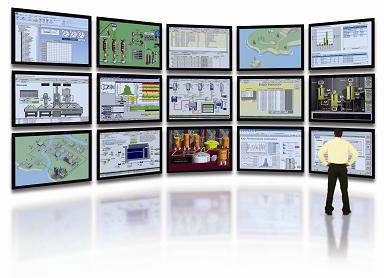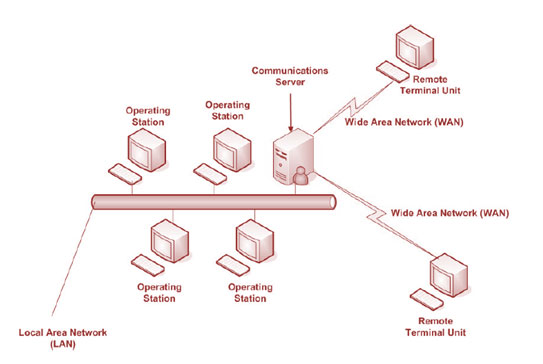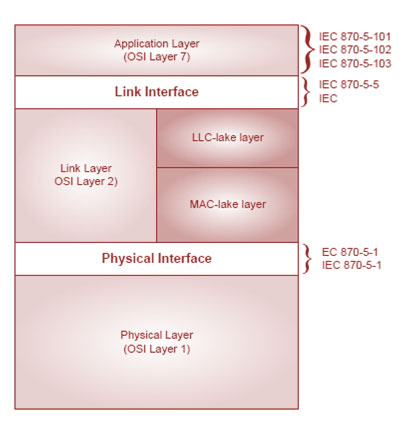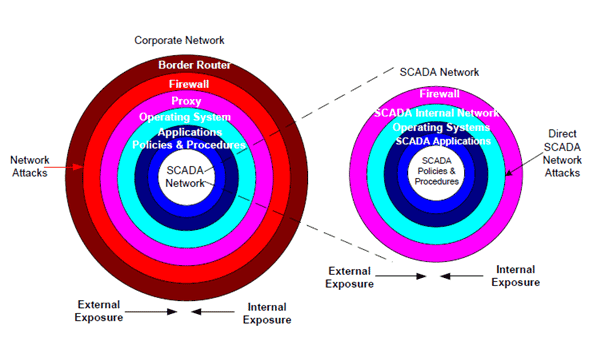The task of routine supervision of industrial machines and processes can be extremely tiring. Always standing next to a machine or patrolling 24/7 around assembly line equipment checking temperature levels, water levels, oil levels and performing other checks would be considered a waste of experience of the technician in trivial tasks. But to free themselves from this onerous task, engineers developed equipment and sensors that would prevent or at least reduce the frequency of these routine checks. As a result of this, control systems and their various sources such as SCADA Systems were formed. Supervisory Control and Data Acquisition (SCADA) offers the ease of monitoring sensors placed remotely from a central location.

Figure 1: Representational image of the SCADA system
History
Supervisory control first evolved in electric utility systems when the need was felt to operate remote substation equipment without sending personnel or line crews to the remote location. In the 1940s, a pair of wires for each unique piece of equipment was used between sites. The potential of multiplexing on a pair of lines was soon put into practice, taking ideas from the Magnetic Stepping Switch developed by telephone companies in the 1930s. With security being an issue, a select-check-operate procedure was adopted, where the operator waited recognizing the device before finally operating it. Taking additional cues from telephone relay systems and their coding schemes, Westinghouse and North Electric Company developed Visicode supervisory control.
General Electric and Control Corporation have also developed their own independent supervisory control programs. They were used in oil pipelines, gas companies and even airports for runway landing lights. These systems became popular during 1950 and 1965. At that time, i.e. in the 1960s, telemetry was developed for monitoring purposes. Before the 1970s, equipment was generally wired, as solid-state devices were in the birth and infancy stages. But with the advent of low-cost computer technology, software and computers made it possible to perform functions previously performed by technicians and seated operators, in addition to panel instruments and tone telemetry.
The first push was given by 8- and 16-bit computers called minicomputers. The second was microprocessors, several years later. Computers offered flexibility in programming and communication with field data acquisition units that previously was done via wired equipment. This was the dawn of SCADA . Many organizations have been involved with the standardization of SCADA systems since then, including the IEEE, the American National Standards Institute, the Electric Power Research Institute, the International Electrotechnical Commission, the DNP3 user group, etc.
Elements of SCADA Systems
SCADA monitors, controls and alarms plant and/or regional facility operating systems from a centralized location. It includes the communication of information between a central SCADA host computer, many dispersed units and/or programmable logic controllers. For example, in a water filtration plant, remote units measure the pressure in the pipes and report the readings to the central computer located somewhere in the control tower. If an anomaly occurred, the SCADA system would alert the main station about the problem, informing it of other details such as the severity of the anomaly and measurement values in an organized manner. Systems can range from simple, such as temperature reporting in a building, to complex, such as monitoring traffic at many traffic lights. The system consists of the following elements:
1. SCADA Master Station Computer Systems: It is the repository of real-time or near real-time reported data collected from the remote terminal units connected to it. It is generally standard computer hardware equipment and very few SCADA system vendors have ventured into manufacturing their own computer equipment. Some companies such as IBM and CDC have attempted to manufacture hardware for this, but the effort was short-lived and off-the-shelf commercial computer products remain the main option. The back-end SCADA software must be capable of repeatedly searching the RTUs for data values and must have software for their retrieval, storage, and processing. Processing may include unit conversion, cataloging in tables, etc.
two. Human-machine interface: This is the attractive part of the host station. The values that have been stored on the host computers are presented to the human operator in an understandable and understandable form through HMIs. They can provide trending, diagnostic, or management information, as well as detailed schematics and animations that represent the current states of the machines under your control. Pictorial representation being more understandable to humans is the preferred form in SCADA HMIs.
Elements of SCADA Cont.
3. Remote Terminal Units (RTUs): An RTU is typically a transducer or sensor that allows the electrical circuit to interface with process instrumentation and control equipment. Physical parameters such as pressure, temperature, etc. are measured through a change in the electrical property of some component of the transducer that is indicative of the physical change. A single RTU can measure many different types of parameters. Depending on the measurement values, the input/output circuit of an RTU can be analog or digital. Analog corresponds to measurements with a numerical range of continuous values that are later converted using an ADC, such as a temperature scale, while digital has a limited number of states (usually two) used primarily for signaling. Specific signals can be generated to control process equipment. Nowadays, RTUs are microprocessor-based devices and these conversions are mostly internal to them.
4. Programmable logic controllers: The use of microprocessors in RTUs has helped RTUs become smarter and have greater functionality. PLCs were built around the philosophy of automation. With reprogramming being the biggest asset, PLC-based RTUs can be debugged and fixed in the field itself along with adding new features like support for multiple polling, exception reporting, time stamping, etc. station. Vendors using different types of communication and coding in this equipment have also led to the standardization of protocols and languages for RTUs, for example, the standardized control programming language, IEC 61131-3. These languages require much less training and are based on an intuitive approach, unlike procedural languages like C and FORTRAN.
5. SCADA communication: The transmission of data from an RTU to the master station and of commands from the host to the RTU needs to be done through a communication system. Furthermore, as a SCADA system may not be located in just a single plant, the vastness of the network must also be addressed, along with speed, accuracy, security and performance, among other important issues. Before computer networking solutions became available, most communication systems were based on voice communication. SCADA communication systems were also built using the same infrastructure and had the same bandwidth limitations. But with the company now wanting to include SCADA information networking in its core networks for security reasons, SCADA systems have also adopted LANs and WANs for seamless integration with everyday office computer networks. This has the advantage for business users that they would not need a separate parallel network for SCADA systems.
Monolithic SCADA
Generations of SCADA Systems
SCADA systems have gone from simple to sophisticated with rapidly changing technology and the timeline can be divided into three generations:
1. Monolithic SCADA Systems: 

Figure 2: Diagram showing the monolithic SCADA system
Due to its origins in times when computing revolved around standalone 'mainframe computers', with virtually non-existent networks. Communication between the RTU and the central computer was a line dedicated exclusively for this purpose. The protocols developed by the vendor had to adapt to their own market and did not offer flexibility of functionality or operability between markets. Redundancy was provided by connecting a similar mainframe at the bus level that continuously monitored and took control of the main computer in the event of a failure.
Distributed SCADA
two. Distributed SCADA Systems: 

Figure 3: Distributed SCADA Systems
Using LAN networks to your advantage, the computational load was distributed across several systems, each system receiving a specific function such as communication processor, calculation processor, database server, etc. This had a geographical extent limitation and could not be used for widely distributed systems. Where LAN protocols were proprietary, vendors developed their own protocols optimized for SCADA systems. The use of WAN to provide communication between the RTUs and the main distributed system has remained unchanged.
Network SCADA
3. Networked SCADA systems: 

Figure 4: Networked SCADA systems
Based on the second generation, it follows an open system architecture rather than a vendor-controlled environment. Using open standards alleviates many limitations, allowing cross-vendor compatibility and the use of any off-the-shelf standard product. This has caused vendors to abandon hardware manufacturing and bring companies like HP, Compaq, and Sun Microsystems into the hardware manufacturing game. The use of WAN networks as the Internet protocol for communication separated the main master station from the network through the use of an intervening communications server, thus adding another layer of security to data and improved disaster survivability.
Protocols and layers
Protocols and Layers 

Figure 5: SCADA protocols and layers
In a SCADA system, an RTU generally does not know what it is measuring. It's just following orders and reporting. It is the master station that must know what the data is and whose data it is. For this, there are protocols to be followed. Each protocol has two divisions: The Master Protocol, containing instructions from the master to the RTU and the RTU Protocol, containing instructions from the RTU to the main computer. Communication between master and RTU forms an RTU model for IED communications of smart electronic devices, the most popular being the International Electrotechnical Commission (IEC) 60870-5 series and Distributed Network Protocol Version 3 (DPNP3).
With the trend towards open standards, on the one hand SCADA systems have been easily integrated with various industrial systems, but it has also increased the risk of people with less knowledge or less integrity gaining access and control from TCP/IP-based systems. This exposes them to various threats such as denial of service attacks, system downtime, Trojans, password stealing keyloggers, defamation, etc. Therefore, dedicated security layers are required for SCADA systems. Following the 9/11 attacks, Departments of Homeland Security in many countries identified the importance of SCADA systems.
Corporate and SCADA
Merging Enterprise Systems and SCADA 

Figure 6: Figure showing the merger of corporate networks and SCADA systems
SCADA has had a long journey from the obscurity of research laboratories to the industrial mainstream and people's everyday conversation. From monitoring and controlling the quality of the water we feed to the air we breathe, from power plants to automobile factories, SCADA systems have taken root everywhere. Significantly reduces operating labor costs while improving reliability and performance of plants or regional systems. Personnel no longer need to waste time wandering around the site, and as SCADA systems also broadly display the threat level, the urgency and need for a site visit can be a more thoughtfully prioritized decision. SCADA is used by energy companies, utility companies such as water and wastewater services, government agencies such as municipalities, physical locations such as refrigeration plants, manufacturing companies for inventory monitoring, mass transit companies and traffic management, among others. many others.
With every company aiming to maximize profits, one might believe that the human factor is the weakest link in the entire production chain. Minimizing the human factor can be achieved by increasing the level of automation, which SCADA systems actively cater to. With the introduction of PLC devices, these systems have become more intelligent and capable of making decisions at a local level as well. So, as companies seek to extract more profits from their factories and governments increase the capabilities of municipal structures for the greater good, SCADA systems would thrive and help provide accurate data and exert precise control over processes.

